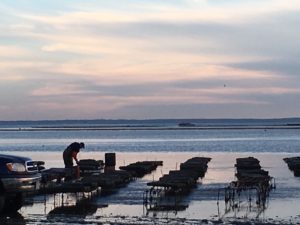WELLFLEET — At a contentious meeting on Tuesday, the Wellfleet Select Board voted 3-0 to limit the number of shellfish racks that may be left on aquaculture grants through the winter and to require that all such equipment be pushed down to be flush with the sea floor. The new regulations are intended to prevent equipment from being torn loose by icy winter tides, creating safety and environmental hazards.
Selectman Michael DeVasto, a shellfish farmer, did not participate in the discussion or vote, and Selectman Kathleen Bacon was absent.
Under the new rules, up to 100 racks per farm may remain in the water over the winter. (Farms may be larger than a single grant, including all contiguous parcels managed by one grant holder.) Farmers can leave more racks out only if they pay a $5 “contingency fee” for each rack over the 100 limit.
The new regulations, proposed by Shellfish Constable Nancy Civetta, also require racks and all other metal and plastic equipment, like hooks used to secure nets, to be removed from the water, or fastened in place on the sea floor, before the arrival of winter ice that would prevent their removal, or by January 15 at the latest.
The old regulations allowed the racks to be up to eight inches off the bottom.
After reviewing Civetta’s proposal, the shellfish advisory board voted 6-1 to support a six-inch rather than eight-inch limit at its Sept. 17 meeting. The board also unanimously opposed the 100-rack limit as well as the $5-per-extra-rack fee.

Some 20 shellfishermen were present at Tuesday’s select board meeting, most voicing objections to the new policy.
Civetta told the Independent she was trying to strike a reasonable balance between two camps: those who want all the equipment removed for the winter and those who feel the regulations are unnecessary. “The shellfish community needs to be responsible and accountable,” she said.
Many growers remove equipment and young oysters to protect them during the winter — a practice known as “pitting.” But some growers have been leaving their equipment out to be able to sell full grown shellfish through the winter when the supply is lower and prices rise. In a Sept. 20 memo to the select board, Civetta acknowledged that the income from having harvestable oysters to sell during the winter “is crucial to making a year-round living here.”
But last winter’s ice buildup left damaged shellfishing racks and other gear scattered around Wellfleet Harbor, creating safety and environmental hazards, according to some town officials. Some of the damaged gear is scooped up by fishing trawlers as they drag the water, Civetta said, causing a dangerous situation for fishermen.
Harbormaster Mike Flanagan and the marina advisory committee both recommended that all shellfishing gear be removed from the harbor entirely before it ices up. In an Aug. 6 memo, committee chair Joseph Aberdale wrote that “the apparatuses remaining pose a threat to safety and navigation, as well as cause problems with the placement of moorings at the start of the boating season.”
Selectman Kathleen Bacon agreed with that recommendation, citing environmental concerns. “I will not support leaving any kind of equipment out in the harbor or our waterways over the winter months when we get ice,” she told her colleagues on Aug. 27. “This stuff is killing us. It’s killing our marine life, it’s killing our water quality.”
This week Bacon told the Independent that she thought the unmoored equipment was polluting the harbor with “rust, acid, and corrosion. If you’ve seen it from the air, it’s frightening how much is out there. There’s acres of racks made of rebar and mesh bags, zip ties, and plastic.”
She referred to images of sea turtles with fishing gear wrapped around their necks. “It’s not pretty,” she said.
Civetta estimated that the 100-rack limit would reduce the number of racks left in the harbor over the winter by about two-thirds, from nearly 3,000 to about 1,000. “We feel that this will significantly improve the situation,” she wrote.

But most shellfishermen at this week’s meeting suggested that the new regulations won’t change much because the $5 fee for each rack over the limit wouldn’t be effective.
“Five dollars is not a deterrent at all,” said one farmer in the crowded room.
Select board chair Janet Reinhart said the farmers need to work more cooperatively and be more responsible for keeping track of their equipment during the winter.
But the farmers at the meeting showed little interest in heeding Reinhart’s advice. When she asked the crowd if they would commit to picking up their gear during the winter she was met with a resounding “No.”
Bacon agreed that the $5 fee would not be an effective deterrent. But Civetta argued for the fee. “If somebody wanted to leave out 200 racks, that’s $1,000,” she told the Independent. “That’s a lot of money.”
Enforcing the new rules on overwintering will strain the shellfish dept.’s resources, Civetta said. She told the select board that it was a challenge for her three-person department to oversee and inspect more than 90 farms, enforce all the rules, and also operate a shellfish propagation program.
“We have to check the grants when they turn in their overwintering agreement to see if they’re in compliance,” she said this week, “and then check again after the ice leaves to see what went missing. We can’t be everywhere at once.” She is planning to ask the town to create another full-time position in her department.
Aberdale told the selectmen that the marina advisory committee favors a stricter tagging system to better identify whose shellfishing equipment is not being collected.
“We would like the board at some point to address the issue of establishing uniformity in the tags used,” he said.
Ryan Fitzgerald lives in Brewster and previously worked as a reporter at the Cape Codder. He is also a sports fan who has worked as an intern for the Cape Cod Baseball League and for WBUR’s “Only a Game.”



